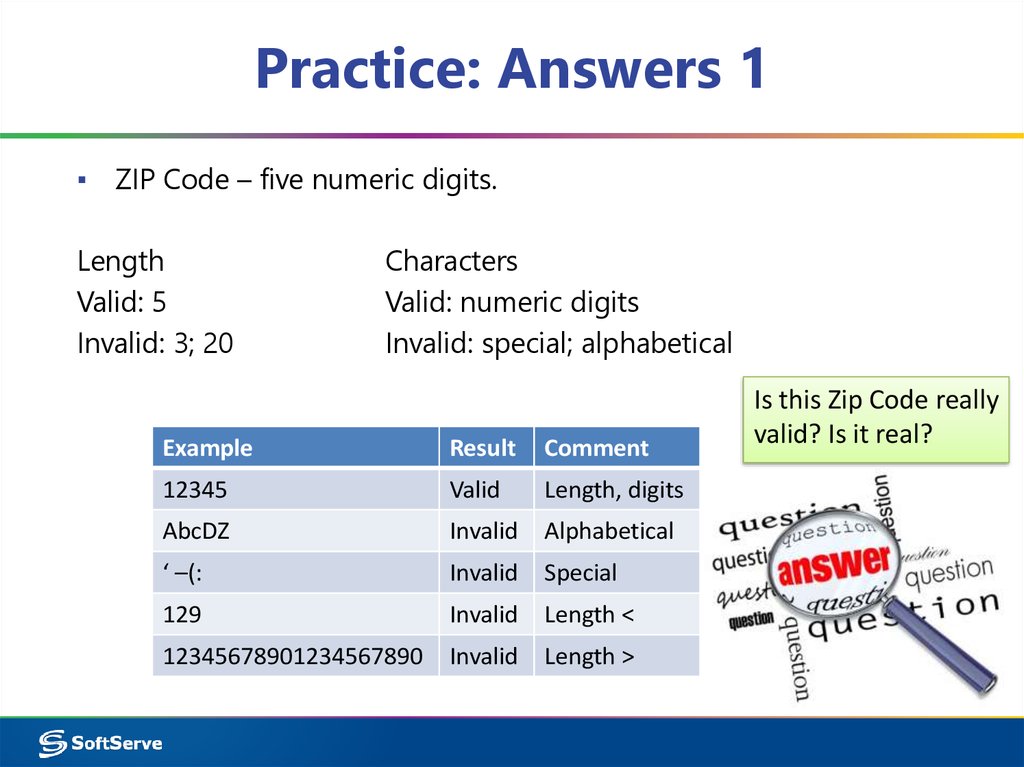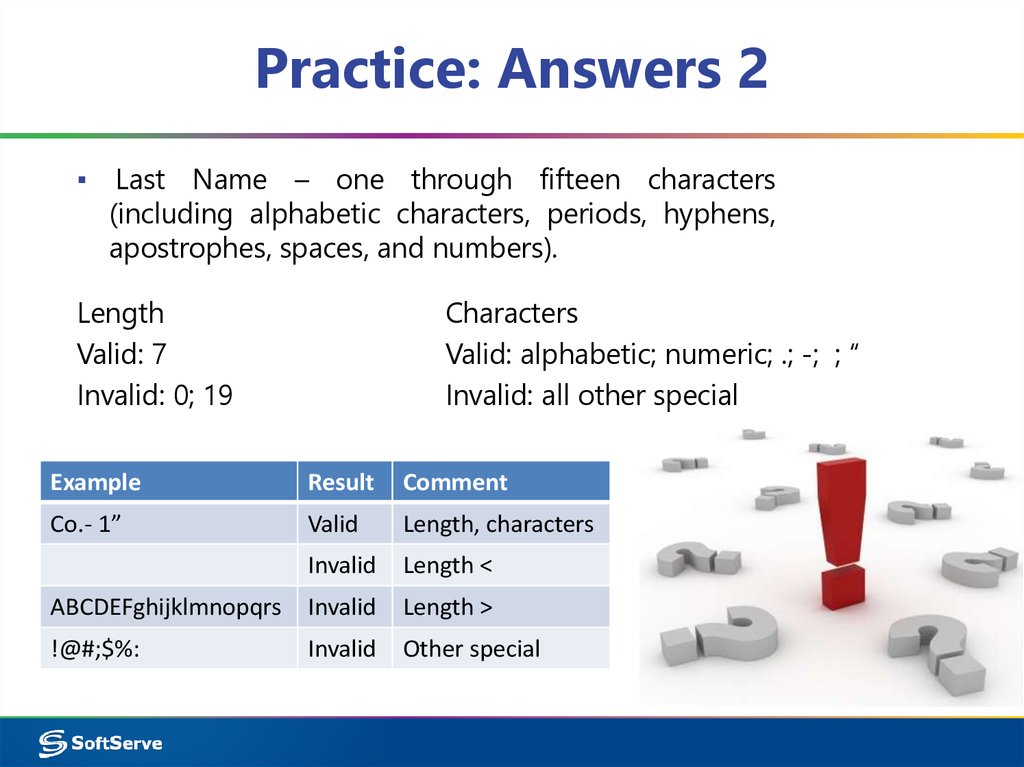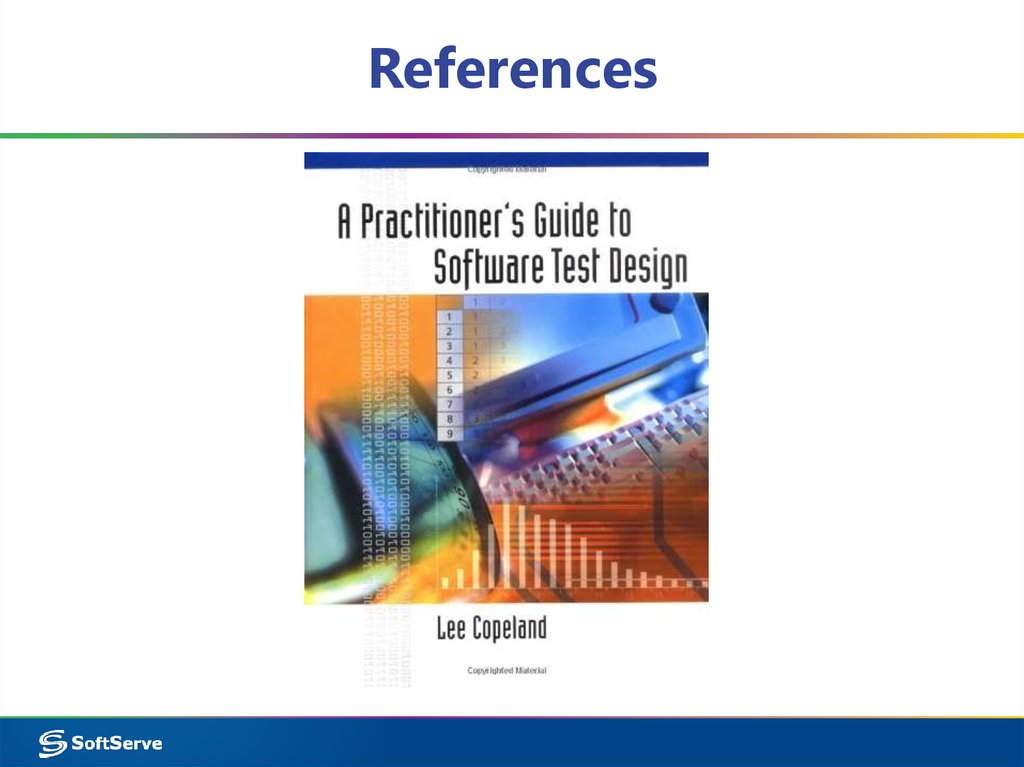Similar presentations:
Equivalence Class Testing Technique Training
1. Equivalence Class Testing Technique Training
Yanina Hladkova2. Agenda
1.2.
3.
4.
5.
6.
7.
Introduction
Technique
Examples
Applicability and Limitations
Summary
Practice
References
3.
4. Introduction
What is equivalence class testing?What is it used for?
Equivalence class testing is
a technique used to reduce
the number of test cases to
a manageable level while
still maintaining reasonable
test coverage.
5. Introduction: Situation
We are writing a module for a human resourcessystem that decides how we should process
employment applications based on a person's age.
Our organization's rules are:
0-16 – Don't hire
16-18 – Can hire on a part-time basis only
18-55 – Can hire as a full-time employee
55-99 – Don't hire
6. Introduction: Coverage
Should we test the module for the following ages:0, 1, 2, 3, 4, 5, 6, 7, 8, ..., 90, 91, 92, 93, 94, 95, 96, 97,
98, 99?
If we had lots of time (and didn't
mind the mind-numbing repetition
and were being paid by the hour)
we certainly could.
100 values
7. Introduction: Solution 1
If (applicantAge == 0) hireStatus="NO";If (applicantAge == 1) hireStatus="NO";
…
If (applicantAge == 15) hireStatus="NO";
If (applicantAge == 16) hireStatus="PART";
If (applicantAge == 17) hireStatus="PART";
If (applicantAge == 18) hireStatus="FULL";
If (applicantAge == 19) hireStatus="FULL";
…
If (applicantAge == 53) hireStatus="FULL";
If (applicantAge == 54) hireStatus="FULL";
If (applicantAge == 55) hireStatus="NO";
If (applicantAge == 56) hireStatus="NO";
…
If (applicantAge == 98) hireStatus="NO";
If (applicantAge == 99) hireStatus="NO";
Any set of tests passes tells us
nothing about the next test we
could execute. It may pass; it
may fail.
8. Introduction: Let’s believe
9. Introduction: Solution 2
If (applicantAge >= 0 && applicantAge <=16)hireStatus="NO";
If (applicantAge >= 16 && applicantAge <=18)
hireStatus="PART";
If (applicantAge >= 18 && applicantAge <=55)
hireStatus="FULL";
If (applicantAge >= 55 && applicantAge <=99)
hireStatus="NO";
It is clear that for the first requirement we don't
have to test 0, 1, 2, ... 14, 15, and 16. Only one
value needs to be tested. And which value? Any
one within that range is just as good as any
other one. The same is true for each of the
other ranges. Ranges such as the ones
described here are called equivalence classes.
10. Introduction: Benefits
Using the equivalence class approach, we havereduced the number of test cases
From 100 (testing each age)
To 4 (testing one age in each equivalence class)
A significant savings
11. Introduction: Definition
An equivalence class consists of a set of data that istreated the same by the module or that should
produce the same result. Any data value within a
class is equivalent, in terms of testing, to any other
value.
12. Introduction: Assumptions
Specifically, we would expect that:▪ If one test case in an equivalence class detects a defect, all
other test cases in the same equivalence class are likely to
detect the same defect.
▪ If one test case in an equivalence class does not detect a
defect, no other test cases in the same equivalence class is
likely to detect the defect.
13. Introduction: Solution 3
If (applicantAge >= 0 && applicantAge <=16)hireStatus="NO";
If (applicantAge >= 16 && applicantAge <=18) hireStatus="PART";
If (applicantAge >= 18 && applicantAge <=41) hireStatus="FULL";
// strange statements follow
If (applicantAge == 42 && applicantName == "Lee")
hireStatus="HIRE NOW AT HUGE SALARY";
If (applicantAge == 42 && applicantName <> "Lee")
hireStatus="FULL";
// end of strange statements
If (applicantAge >= 43 && applicantAge <=55) hireStatus="FULL";
If (applicantAge >= 55 && applicantAge <=99) hireStatus="NO";
14. Introduction: Ready?
Now, are we ready to begin testing?Probably not.
What about input values like 969, -42,
FRED, and &$#!@? Should we create
test cases for invalid input?
The answer is, as any good consultant
will tell you, "it depends“.
15.
Technique16. Technique: Steps
1. Identify the equivalence classes.2. Create a test case for each equivalence class.
You could create additional test cases for each
equivalence class if you have time and money.
Additional test cases may make you feel warm and
fuzzy, but they rarely discover defects the first
doesn't find.
17. Technique: Continuous
Continuous equivalence classesFor a valid input we might choose $1,342/month. For
invalids we might choose $123/month and $90,000/month.
18. Technique: Discrete
Discrete equivalence classesFor a valid input we might choose 2 houses. Invalids could
be -2 and 8.
19. Technique: Array
Single selection equivalence classesFor a valid input we must use "person." For an invalid we
could choose "corporation" or "trust" or any other random
text string. How many invalid cases should we create? We
must have at least one; we may choose additional tests for
additional warm and fuzzy feelings.
20. Technique: Array
Multiple selection equivalence classWhile the rule says choose one test case from the valid
equivalence class, a more comprehensive approach would
be to create test cases for each entry in the valid class. That
makes sense when the list of valid values is small.
21. Technique: Contradictions
But, if this were a list of the fifty states, and the variousterritories of the United States, would you test every one of
them? What if in the list were every country in the world?
The correct answer, of course, depends on the risk to the
organization if, as testers, we miss something that is vital.
22. Technique: Combination
Rarely we will have the time to create individual tests forevery separate equivalence class of every input value.
Test cases of valid data values.
Monthly Number of
Dwelling
Applicant
Result
Income Dwellings
Types
$5,000
1
Person
Condo
Valid
$1,389
4
Person SingleFam Valid
$10,000
3
Person Townhouse Valid
23. Technique: All invalid
A test case of invalid data values.Monthly Number of
Income Dwellings
$100
8
Dwelling
Types
Result
Partnership Treehouse
Invalid
Applicant
If the system accepts this input as valid, clearly the system is
not validating the four input fields properly. If the system
rejects this input as invalid, it may do so in such a way that
the tester cannot determine which field it rejected. For
example: ERROR: 653X-2.7 INVALID INPUT
24. Technique: One invalid
In many cases, errors in one input field may cancel out ormask errors in another field so the system accepts the data
as valid. A better approach is to test one invalid value at a
time to verify the system detects it correctly.
A set of test cases varying invalid values one by one.
Monthly Number of
Applicant
Income Dwellings
$100
1
Person
$1,342
0
Person
$1,342
1
Corporation
$1,342
1
Person
Dwelling
Types
SingleFam
Condo
Townhouse
Treehouse
Result
Invalid
Invalid
Invalid
Invalid
25. Technique: Varying values
For additional warm and fuzzy feelings, the inputs (bothvalid and invalid) could be varied.
A set of test cases varying invalid values one by one but also
varying the valid values.
Monthly Number of
Dwelling
Applicant
Result
Income Dwellings
Types
$100
1
Person
SingleFam Invalid
$1,342
0
Person
Condo
Invalid
$5,432
3
$10,000
2
Corporation Townhouse
Person
Treehouse
Invalid
Invalid
26. Technique: Tips
Another approach to using equivalence classes is toexamine the outputs rather than the inputs.
Divide the outputs into equivalence classes, then
determine what input values would cause those
outputs. This has the advantage of guiding the tester to
examine, and thus test, every different kind of output.
But this approach can be deceiving.
In the previous example, for the human resources
system, one of the system outputs was NO, that is,
Don't Hire. A cursory view of the inputs that should
cause this output would yield {0, 1, ..., 14, 15}. Note that
this is not the complete set. In addition {55, 56, ..., 98,
99} should also cause the NO output.
It's important to make sure that all potential outputs
can be generated, but don't be fooled into choosing
equivalence class data that omits important inputs.
27.
Examples28. Examples: 1
No invalid choices.It reduces the number of test cases the tester must create.
Only the valid inputs {Buy, Sell} need to be exercised.
Valid inputs: {Buy, Sell}.
Invalids: {Trade, Punt, ...}.
What about "buy", "bUy", "BUY"? Are these valid or invalid entries? The tester
would have to refer back to the requirements to determine their status.
29. Examples: 2
Input to this field can be between one and four numericcharacters (0, 1, ..., 8, 9) with a valid value greater or equal to 1
and less than or equal to 9999.
Valid inputs are {1, 23, 456, 7890}.
Invalid inputs are {-42, 0, 1.2, 12345, SQE, $#@%}.
30. Examples: 3
The valid symbols are {A, AA, AABC, AAC, ..., ZOLT, ZOMX, ZONA,ZRAN}. The invalid symbols are any combination of characters
not included in the valid list.
Valid inputs are {A, AL, ABE, ACES, AKZOY}.
Invalid inputs are {C, AF, BOB, CLUBS, AKZAM, 42, @#$%}.
31. Examples: 4
Rarely will we create separate sets of test cases for each input. Generally it ismore efficient to test multiple inputs simultaneously within tests. For example,
the following tests combine Buy/Sell, Symbol, and Quantity.
A set of test cases varying invalid values one by one.
Buy/Sell Symbol Quantity Result
Buy
A
10
Valid
Buy
C
20
Invalid
Buy
A
0
Invalid
Sell
ACES
10
Valid
Sell
BOB
33
Invalid
Sell
ABE
-3
Invalid
32.
Applicability andLimitations
33. Applicability and Limitations
▪ Equivalence class testing can significantly reduce thenumber of test cases that must be created and executed. It
is most suited to systems in which much of the input data
takes on values within ranges or within sets. It makes the
assumption that data in the same equivalence class is, in
fact, processed in the same way by the system. The
simplest way to validate this assumption is to ask the
programmer about their implementation.
▪ Let your designers and programmers know when they
have helped you. They'll appreciate the thought and may
do it again.
34. Applicability and Limitations
▪ Very often your designers and programmers use GUIdesign tools that can enforce restrictions on the length
and content of input fields. Encourage their use. Then your
testing can focus on making sure the requirement has
been implemented properly with the tool.
▪ Equivalence class testing is equally applicable at the unit,
integration, system, and acceptance test levels. All it
requires are inputs or outputs that can be partitioned
based on the system's requirements.
35.
Summary36. Summary
▪ Equivalence class testing is a technique usedto reduce the number of test cases to a
manageable size while still maintaining
reasonable coverage.
▪ This simple technique is used intuitively by
almost all testers, even though they may not
be aware of it as a formal test design method.
▪ An equivalence class consists of a set of data
that is treated the same by the module or that
should produce the same result. Any data
value within a class is equivalent, in terms of
testing, to any other value.
37.
Practice38. Practice
▪ ZIP Code – five numeric digits.▪ Last Name – one through fifteen characters
(including alphabetic characters, periods, hyphens,
apostrophes, spaces, and numbers).
▪ User ID – eight characters at least two of which are
not alphabetic (numeric, special).
▪ Student ID – eight characters. The first two
represent the student's home campus while the last
six are a unique six-digit number. Valid home
campus abbreviations are: AN, Annandale; LC, Las
Cruces; RW, Riverside West; SM, San Mateo; TA,
Talbot; WE, Weber; and WN, Wenatchee.
39. Practice: Answers 1
▪ ZIP Code – five numeric digits.Length
Valid: 5
Invalid: 3; 20
Characters
Valid: numeric digits
Invalid: special; alphabetical
Example
Result
Comment
12345
Valid
Length, digits
AbcDZ
Invalid
Alphabetical
‘ –(:
Invalid
Special
129
Invalid
Length <
12345678901234567890
Invalid
Length >
Is this Zip Code really
valid? Is it real?
40. Practice: Answers 2
▪ Last Name – one through fifteen characters(including alphabetic characters, periods, hyphens,
apostrophes, spaces, and numbers).
Length
Valid: 7
Invalid: 0; 19
Characters
Valid: alphabetic; numeric; .; -; ; “
Invalid: all other special
Example
Result
Comment
Co.- 1”
Valid
Length, characters
Invalid
Length <
ABCDEFghijklmnopqrs
Invalid
Length >
!@#;$%:
Invalid
Other special
41. Practice: Answers 3
▪ User ID – eight characters at least two of which arenot alphabetic (numeric, special).
Length
Valid: 8
Invalid: 2; 11
Number of numeric and special characters
Valid: 2
Invalid: 1; 10
Example
Result
Comment
1!abcDYZ
Valid
Length, number
2%
Invalid
Length <
0#?(cyzagq4
Invalid
Length >
abcptu6w
Invalid
Number <
“(/\,.123+
Invalid
Number >
42. Practice: Answers 4
▪Student ID – eight characters. The first two represent the student's home campus
while the last six are a unique six-digit number. Valid home campus abbreviations
are: AN, Annandale; LC, Las Cruces; RW, Riverside West; SM, San Mateo; TA, Talbot;
WE, Weber; and WN, Wenatchee.
Length
Valid: 8
Invalid: 5; 10
Characters position
Valid: first 2
Invalid: 3d and 4th
Campus
Valid: in the list
Invalid: other
Example
Result
Comment
AN123409
Valid
Length, position, campus, unique
LC136
Invalid
Length <
TA98765432 Invalid
Length >
12SM4446
Invalid
Position
AC963201
Invalid
Campus
AN123409
Invalid
Not unique
Unique
Valid: unique
Invalid: not unique
43. Practice: Answers 5
NZIP Code
Last Name
User ID
Student ID
Result
1 12345
Co.- 1”
1!abcDYZ
AN123409
Valid
2 AbcDZ
KolirtypUedv
LDKW9456
LC874562
Invalid
3 ‘ –(:
.- 2”34567890'.
Poief63t
RW456732
Invalid
4 129
………….
&)^ASGYK
SM687414
Invalid
5 12345678901234567890
------------
KOfd27,.
TA312458
Invalid
!@#;$%:?
WE965874
Invalid
6 67890
7 11111
!@#;$%:
12378964
WN221133
Invalid
8 23487
ABCDEFghijklmnopqrs 09876,=_
SM747498
Invalid
9 89453
'''
2%
TA321987
Invalid
10 09342
PODSAF
0#?(cyzagq4 WE126542
Invalid
11 34567
lju77 fsd 5
abcptu6w
WN369874
Invalid
12 09789
Lopwefdvc
“(/\,.123+
AN546887
Invalid
13 19823
se.rt3456
Ty_1236*
LC136
Invalid
14 73287
1594
;ldfskt8
TA98765432 Invalid
15 64785
43
3333UOPQ
12SM4446
Invalid
16 98883
R
pn7f1uN6
AC963201
Invalid
17 19823
yu
n8m!c~2{
AN123409
Invalid














































 english
english








